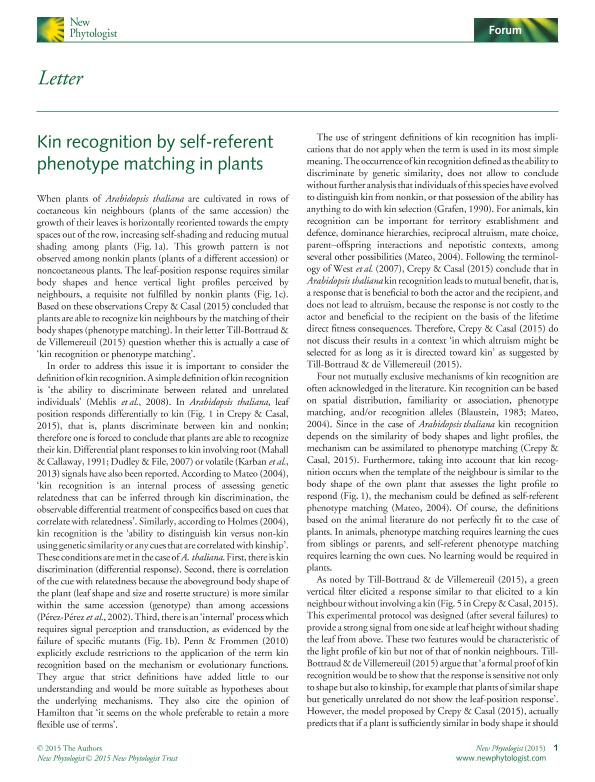Artículo
Kin recognition by self-referent phenotype matching in plants
Fecha de publicación:
01/2016
Editorial:
Wiley Blackwell Publishing, Inc
Revista:
New Phytologist
ISSN:
0028-646X
Idioma:
Inglés
Tipo de recurso:
Artículo publicado
Clasificación temática:
Resumen
When plants of Arabidopsis thaliana are cultivated in rows ofcoetaneous kin neighbours (plants of the same accession) thegrowth of their leaves is horizontally reoriented towards the emptyspaces out of the row, increasing self-shading and reducing mutualshading among plants (Fig. 1a). This growth pattern is notobserved among nonkin plants (plants of a different accession) ornoncoetaneous plants. The leaf-position response requires similarbody shapes and hence vertical light profiles perceived byneighbours, a requisite not fulfilled by nonkin plants (Fig. 1c).Based on these observations Crepy & Casal (2015) concluded thatplants are able to recognize kin neighbours by the matching of theirbody shapes (phenotype matching). In their letter Till-Bottraud&de Villemereuil (2015) question whether this is actually a case of?kin recognition or phenotype matching?.
Palabras clave:
Kin Recognition
,
Self-Referent Matching
,
Neighbour Plant
,
Light Signals
Archivos asociados
Licencia
Identificadores
Colecciones
Articulos(IFEVA)
Articulos de INST.D/INV.FISIOLOGICAS Y ECO.VINCULADAS A L/AGRIC
Articulos de INST.D/INV.FISIOLOGICAS Y ECO.VINCULADAS A L/AGRIC
Articulos(SEDE CENTRAL)
Articulos de SEDE CENTRAL
Articulos de SEDE CENTRAL
Citación
Crepy, Maria Andrea; Casal, Jorge José; Kin recognition by self-referent phenotype matching in plants; Wiley Blackwell Publishing, Inc; New Phytologist; 209; 1; 1-2016; 15-16
Compartir
Altmétricas




